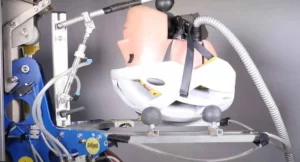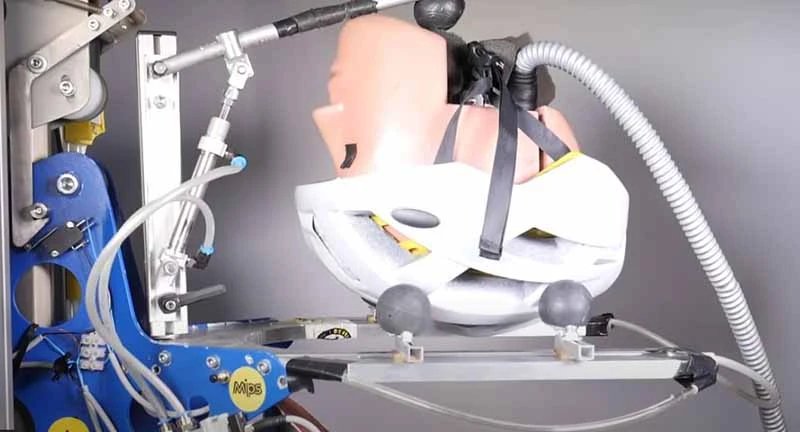The Influence of Direct Consumer Helmets: Marketing & Innovation
Question 1:
-
Global
The global market size for motorcycle helmets grew from $3.2 billion in 2018 to $3.3 billion in the year 2020, amid the COVID-19 crisis, and is projected to reach $4.9 billion by 2027, growing at a CAGR (Compound Annual Growth Rate) of 5.7% over the 7-year forecast period.
-
Country
The U.S. market size is estimated at more than $898.8 million. China is expected to reach a projected market size of $1 billion by 2027, trailing a CAGR of 8.8%. Other honorable mentions are Canada and Japan, each expected to grow at 5.1% and 3.1% respectively over the same forecast period. Within Europe, Germany is forecast to grow at about 3.6% CAGR.
-
Region
Regionally, North America is the largest market worldwide because of the continuous rise in motorcycle sales. The U.S. represents the major motorcycle helmet market in North America and accounts for 27.08% share of the global market. Such statistics make the country a highly lucrative market for motorcycle helmets. But the Asia-Pacific region is poised to be the fastest-growing market during the forecast period. Analysts estimate between 10 and 20 million motorcycle helmet sales in 2021.
-
Market Segment
The global full-face segment is estimated to record a 4.9% CAGR and reach $2.1 billion by the end of the forecast period. While Canada, the USA, China, Japan, and Europe will drive the estimated 3.6% CAGR for the open-face segment. These regional markets accounted for a $171.7-million combined market size in 2020 and are projected to reach $220.6 million by the end of the forecast period. China will remain among the fastest growing in this group of regional markets.
Led by nations like South Korea, India, and Australia, the Asia-Pacific open-face helmet market is projected to reach $658.5 million by 2027, while Latin America will grow at 5.4% CAGR between 2020 and 2027.
Essentially, the growth in market value and production units is attributed to the increased cases of road and track accidents, necessitating more stringent safety adoption measures. Other factors that help to throttle the growth include the rising awareness of enhanced comfort, the introduction of multifunctional smart helmets, ongoing racing events, the heightened popularity of owning a sports bike and bespoke modifications in the aftermarket among the millennials, and the rising number of clubs and communities of bikers acting as a platform.
Question 2
The major players are Arai Helmet Ltd, AGV (Subsidiary of Dainese), HJC Helmets, Bell Helmets, Schuberth GmbH, and Shoei Co. Ltd. Other noteworthy mentions include Chih Tong Helmet Co. Ltd, Lazer SA, NZI Technical Protection SL (NZI Helmets), Nolangroup SpA, and Vega Helmet Corporation.
Many key suppliers capitalize on the U.S. growing motorcycle market to increase their profitability. Over the last few years, U.S. companies and those across the globe have actively engaged in continuous research and development to design advanced helmets that meet market requirements and specifications.
For instance:
- KLIM, a Rigby-based firm, in March 2020 invented the F3 Carbon motorcycle helmets weighing 2.34 lb. for riders who are interested in lighter helmets.
- What’s more, in September 2020, Zeus Helmet, a Taiwan-based company, specializes in the manufacture of Carbon Fiber Helmets ZX-1800B (full-face helmet) and ZS-608 (open-face), which have full and open space features.
- In 2019, Arai Helmet, a Japanese firm, started to produce fiberglass-reinforced helmets with less weight convenient for modern users. The company also renewed its partnership with American Flat Track.
Other firms, including HJC Europe, Shoei Co Ltd, and Dainese SPA, are also key players serving the U.S. growing market for motorcycle helmets. They all have unique helmets, designed to serve a particular market segment.
Question 3
In 2020, approximately 80% of motorcycle helmet manufacturers had capitalized on technological integration in their final products. Today, the technological adoption rate has significantly risen following the COVID-19 impact and the need to embrace safety measures.
As a result, manufacturers are now designing smart helmets fitted with thermostats that measure people’s temperatures from a significant distance. The technology uses thermal scanning to measure a client’s temperature within a few seconds and predict their COVID-19 status. Likewise, companies now fit smart helmets with cameras, mounted tools, and sensors that help people capture data, make informed decisions, and signal caution in case of an accident. The helmets have mapping devices, GPS cameras, navigation tools, and heart rate monitors that send instant alerts to friends and families during critical and emergent situations.
Such a high technological adoption rate has been exacerbated by stringent policies dictating safety measures to reduce road accidents caused by motorcycles. The adoption of smart helmets is projected to reduce road accident mortality rates by 40% and fatal injuries by 70%.
Question 4
Growth in the motorcycle helmet industry has resulted in technological integration at the end user profiles. The premium motorcycle helmet market value, which was estimated at $701.46 million in 2020, is projected to reach $1.1 billion by 2027, growing at 6.81% CAGR during the forecast period (2021 – 2027). The market is segmented by end-user, distribution channel, geography, and material type.
- Material Type: The market is segmented into carbon fiber, plastics, and carbon fiber.
- Distribution Channel: The market is segmented into online and offline (helmet manufacturing showroom, motorcycle showroom, and aftermarket.)
- End-User: The market is segmented into racers and commuters.
In essence, premium helmets incorporate smart digital technologies, including thermostats to measure temperatures and global positioning systems for easy navigation and communication while taking rides. These helmets are also made of superior materials such as thermosets resin plastics, synthetic fiber, fiberglass, and carbon fibers to enhance security and provide extreme tensile strength. They are lightweight and compact in size, with a streamlined design that makes them more convenient and comfortable for riders.
Manufacturers equip premium helmets with washable and removable interior padding that removes sweat quicker than other regular helmets. What’s more, premium helmets are better than other products in the place as they come with Bluetooth connectivity, allowing people to communicate while riding.
Such outstanding features make premium helmets highly recommendable compared to traditional alternatives.
Question 5
Innovation is a critical component highly valued in the U.S. helmet industry. Key players are now integrating additional features to increase riders’ safety and reduce road accidents rising by the day. Manufacturers are now adding ventilation systems in helmets to provide a cool atmosphere to riders on a hot day. These helmets use solar panels or batteries to power fans used to reduce heat inside helmets on a warm day. As the helmet’s warmness creates an uncomfortable atmosphere, manufacturers are innovating techniques that give fundamental solutions to such challenges.
Likewise, manufacturers are designing rear-view helmets that help riders to assess their surroundings before changing lanes. Traditional helmets block riders’ line of view forcing them to look over their shoulders or take their eyes off the road when making a turn or changing lanes. The rear-view helmets ensure riders get a complete view of what is surrounding them while remaining upfront. They are equipped with cameras that display surroundings in real-time in front of the helmet. As a result, the technology reduces the chances of causing accidents when riders change lanes.
Furthermore, manufacturers have noted riders’ visibility to be an essential aspect in reducing accidents especially in inclement weather and during the night. As a result, they have equipped helmets with LED lights that act as turn signals, brake lights, and improve the visibility of riders to see and be seen. Such innovative features work to reduce the increased number of road accidents caused by riders in the country. Lastly, the latest innovation is heads-up displays in motorcycle helmets that allow riders to see traveling speed, and GPS data, and receive or make a call through a smartphone. These developments exhibit the extent of technological integration and innovation in motorcycle helmets to enhance convenience in riding.
Question 6
Currently, manufacturers are focusing on better digital innovations in motorcycle helmets. Applications including app-powered audios, augmented realities, emergency response, and camera safety have been at the forefront of numerous motorcycle helmet development brands. App-powered audio capitalizes on applications including Bluetooth that enables riders to make calls, receive calls, and navigate instructions from other riders without getting their hands on the handlebars. These features are also capable of reducing fatigue-induced engine noise that is highly audible when riding. Such inventions ensure the rider’s total concentration while on the road.
Furthermore, manufacturers project the installation of augmented reality (AR) in motorcycle helmets in the foreseeable future. This feature will help riders to read speedometers and GPS maps without lifting their eyes off the handlebars, thereby reducing distracted driving. In the meantime, manufacturers assign AR prototypes on standard helmets through a handle-bar controlled unit, add-on, and display on the helmet’s chin bar.
Question 7
There is no specific cost added for innovations as numerous manufacturers prioritize offering solutions to problems caused by traditional helmets. Each company, including Fox, AGV, Arai, and Caberg, has its unique budgetary costs for designing helmets as per their innovative prospects. Other manufacturers add costs to reduce risks associated with brain injuries while others prioritize rider convenience and comfort. Based on such perspectives, the cost added for inventions varies across numerous manufacturers.
The market is more performance-driven than cost driven. Each key player is working to equip their helmet brands with the latest technology convenient for their brand and users. The result ensures that brands stay ahead of the competition by offering products that specifically meet consumer needs and expectations. The ability to serve particular market segments precisely increases a brand’s performance.
Question 8
Yes. There are numerous past innovations and needs leaving unsatisfied amongst numerous motorcycle helmets in the U.S. Specifically, the novelty helmet has not yet improved nor followed the DOT (Department of Transportation) stipulation regarding safety standards in motorcycle ridings. As a result, novelty helmets remain highly inefficient and very scary. They only provide protection to limited accident scenarios, especially where accidents are caused by linear accelerations.
Thus, the novelty helmet only protects riders against straight-on impacts. The result is due to little development in testing parameters ever since 1974 when DOT established the first rules for helmet regulations in America. Hence, the helmet industry should improve its practices to test helmets more on angular accelerations, and other road prevention efficiency tests. The result should be the basis for further improvement in the future.
Question 9
Flame retardants and thermal management are crucial factors in the motorcycle helmet industry. Many times, motorcycles engage in accidents and are at a high risk of overheating and subsequently burning. Flame retardants come in handy as they equip helmets with combustible materials that prevent fire from starting and slowly spreading in case of an accident or outbreak.
These flame retardants also create lead time for escape. Alternatively, thermal management ensures that helmets maintain a conducive and cool environment inside helmets. Most times, riders suffer from excessive heat caused by the sun’s radiation on a hot and sunny day. As a result, equipping helmets with thermal regulation tools help riders enjoy the convenient atmosphere artificially created by helmets on a sunny day.
You May Also Like:
US Motorcycle Helmet Standard: DOT, ECE 22.5
European Motorcycle Helmet Standards: A Detailed Guide
M/A















